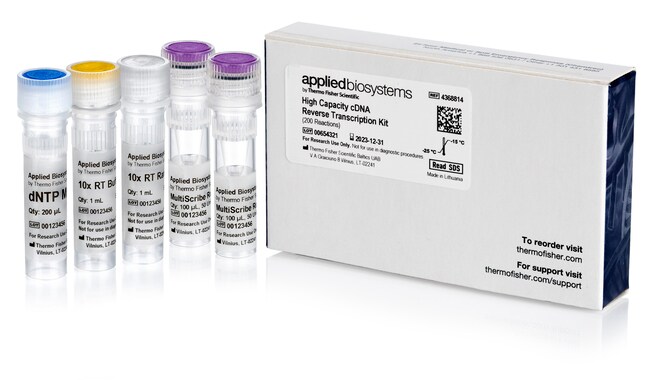Search Thermo Fisher Scientific

Zertifikate
SDB
Zitierungen und Referenzen (1122)
Applied Biosystems™
High-Capacity cDNA Reverse Transcription Kit
Das Kit zur reversen Transkription von cDNA mit hoher Kapazität enthält alle Komponenten, die für die quantitative Umschreibung von bisWeitere Informationen
| Katalognummer | Enthält | Anzahl Reaktionen |
|---|---|---|
| 4368814 | Kit only | 200 Reaktionen |
| 4374966 | Kit with Rnase Inhibitor | 200 Reaktionen |
| 4368813 | Kit only | 1.000 Reaktionen |
| 4374967 | Kit with Rnase Inhibitor | 1.000 Reaktionen |
Katalognummer 4368814
Preis (EUR)
366,60
Special offer
Online exclusive
Endet: 15-Aug-2025
564,00Ersparnis 197,40 (35%)
Each
Vorrätig
Enthält:
Kit only
Anzahl Reaktionen:
200 Reaktionen
Preis (EUR)
366,60
Special offer
Online exclusive
Endet: 15-Aug-2025
564,00Ersparnis 197,40 (35%)
Each
Das Kit zur reversen Transkription von cDNA mit hoher Kapazität enthält alle Komponenten, die für die quantitative Umschreibung von bis zu 2 µg Gesamt-RNA in einsträngige cDNA in einer einzigen 20 µl-Reaktion erforderlich sind. Das High Capacity cDNA Reverse Transcription Kit erzeugt einsträngige cDNA höchster Qualität ausgehend von 0,02 bis 2 µg Gesamt-RNA. Reaktionen sind zum Erzeugen von 10 µg cDNA aus einer einzelnen Reaktion auf bis zu 100 µl skalierbar. Nachfolgende Anwendungen umfassen Real-Time PCR, Standard-PCR und Mikroarrays. Das Kit ist ideal für die Generierung von cDNA-Archiven.
Zu den Merkmalen dieses Kits gehören:
• Lineare Amplifikation des Targets für die Real-Time PCR
• Höhere Ausbeute und Präzision als bei anderen cDNA-Synthesekits zu einem Bruchteil der Kosten
• 10 Mal größerer dynamischer Bereich als bei anderen Kits
Ausgiebig getestet mit einer Vielzahl von Templates
Die quantitative Erststrangsynthese aller RNA-Spezies wird durch die Verwendung von Random-Primern erreicht. Das Kit wurde an zahlreichen RNA-Templates, einschließlich GC- und AU-reicher Ziele sowie bei niedrigen Konzentrationen exprimierter RNA, ausgiebig getestet. cRNA kann auch durch In-vitro-Transkription von cDNA effektiv erzeugt werden.
Zu den Merkmalen dieses Kits gehören:
• Lineare Amplifikation des Targets für die Real-Time PCR
• Höhere Ausbeute und Präzision als bei anderen cDNA-Synthesekits zu einem Bruchteil der Kosten
• 10 Mal größerer dynamischer Bereich als bei anderen Kits
Ausgiebig getestet mit einer Vielzahl von Templates
Die quantitative Erststrangsynthese aller RNA-Spezies wird durch die Verwendung von Random-Primern erreicht. Das Kit wurde an zahlreichen RNA-Templates, einschließlich GC- und AU-reicher Ziele sowie bei niedrigen Konzentrationen exprimierter RNA, ausgiebig getestet. cRNA kann auch durch In-vitro-Transkription von cDNA effektiv erzeugt werden.
Nur für Forschungszwecke. Nicht zur Verwendung bei diagnostischen Verfahren.
Specifications
Konzentration50 U/μl
EndprodukttypcDNA (Erststrang)
FormatKit
EnthältKit only
Anzahl Reaktionen200 Reaktionen
Optimale Reaktionstemperatur37 °C
Menge200 Reaktionen
ReaktionsformatSeparate Komponenten
ReagenztypReverse Transkription
Reverse TranskriptaseMultiScribe
Ribonuklease-H-AktivitätJa
VersandbedingungTrockeneis
Größe (Endprodukt)max. 7 kb
AusgangsmaterialRNA
VerfahrenReverse Transkription
Zur Verwendung mit (Anwendung)Real Time PCR (qPCR)
Reaktionsgeschwindigkeit120 min
Unit SizeEach
Inhalt und Lagerung
• 10X-RT-Puffer, 1 ml
• 10X RT Random Primer, 1 ml
• 25X-dNTP-Mix, 0,2 ml (100 mM)
• MultiScribe Reverse Transkriptase, 0,1 ml (50 E/μl)
Lagerung bei –25 °C bis –15 °C.
Have questions about this product? Ask our AI assisted search.
This is an AI-powered search and may not always get things right. You can help us make it better with a thumbs up or down on individual answers or by selecting the “Give feedback" button. Your search history and customer login information may be retained by Thermo Fisher and processed in accordance with our
Privacy Notice.
Häufig gestellte Fragen (FAQ)
Customers who viewed this item also viewed
Dokumente und Downloads
Zertifikate
Nach Chargennummer oder Teil-Chargennummer suchen
Chargen-Nr.Certificate TypeDateCatalog Number(s)
3278759Certificate of Analysis14. Juli 20254368813
3278362Certificate of Analysis11. Juli 20254374967
3278643Certificate of Analysis11. Juli 20254368814
3277086Certificate of Analysis09. Juli 20254368813
3275909Certificate of Analysis08. Juli 20254374966
5 Ergebnisse angezeigt, oben nach einem bestimmten Zertifikat suchen
Sicherheitsdatenblätter
SDB
Zitierungen und Referenzen (1122)
Search citations by name, author, journal title or abstract text
Zitierungen und Referenzen
Abstract
Hyaluronan-CD44-ERK1/2 regulate human aortic smooth muscle cell motility during aging.
Journal:The Journal of biological chemistry
PubMed ID:18077444
Increased hepatobiliary clearance of unconjugated thyroxine determines DMP 904-induced alterations in thyroid hormone homeostasis in rats.
Journal:Toxicological sciences : an official journal of the Society of Toxicology
PubMed ID:15673846
4-(3-pentylamino)-2,7-dimethyl-8-(2-methyl-4-methoxyphenyl)-pyrazolo-[1,5-a]-pyri midine (DMP 904) is a potent and selective antagonist of corticotropin releasing factor receptor-1 (CRF1 receptor) with an efficacious anxiolytic profile in preclinical animal models. In subchronic toxicity studies in Sprague-Dawley rats, DMP 904 produced thyroid follicular cell hypertrophy and hyperplasia, and a low incidence of follicular cell
In vitro and in vivo enhanced generation of human A9 dopamine neurons from neural stem cells by Bcl-XL.
Journal:J Biol Chem
PubMed ID:20106970
Human neural stem cells derived from the ventral mesencephalon (VM) are powerful research tools and candidates for cell therapies in Parkinson disease. Previous studies with VM dopaminergic neuron (DAn) precursors indicated poor growth potential and unstable phenotypical properties. Using the model cell line hVM1 (human ventral mesencephalic neural stem cell
Tamoxifen increases nuclear respiratory factor 1 transcription by activating estrogen receptor beta and AP-1 recruitment to adjacent promoter binding sites.
Journal:Faseb J
PubMed ID:21233487
Little is known about endogenous estrogen receptor beta (ERbeta) gene targets in human breast cancer. We reported that estradiol (E(2)) induces nuclear respiratory factor-1 (NRF-1) transcription through ERalpha in MCF-7 breast cancer cells. Here we report that 4-hydroxytamoxifen (4-OHT), with an EC(50) of ~1.7 nM, increases NRF-1 expression by recruiting
Calcineurin/nuclear factor of activated T cells and MAPK signaling induce TNF-{alpha} gene expression in pancreatic islet endocrine cells.
Journal:J Biol Chem
PubMed ID:21059644
Cytokines contribute to pancreatic islet inflammation, leading to impaired glucose homeostasis and diabetic diseases. A plethora of data shows that proinflammatory cytokines are produced in pancreatic islets by infiltrating mononuclear immune cells. Here, we show that pancreatic islet alpha cells and beta cells express tumor necrosis factor-alpha (TNF-alpha) and other
1122 total citations